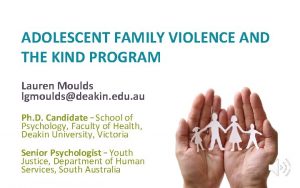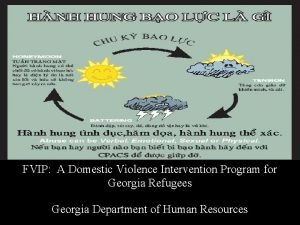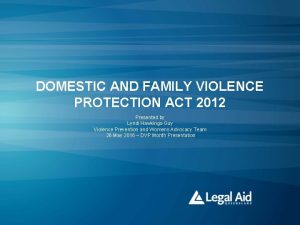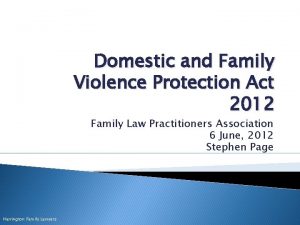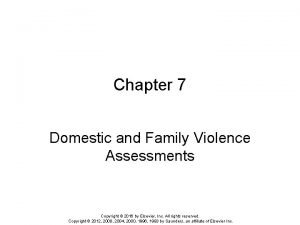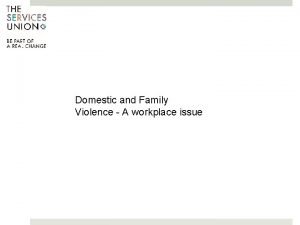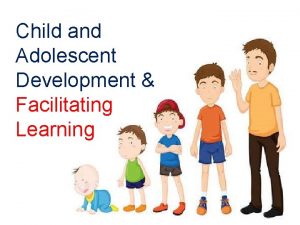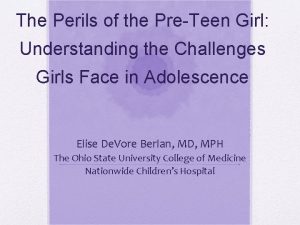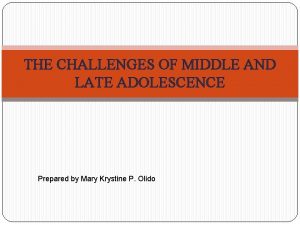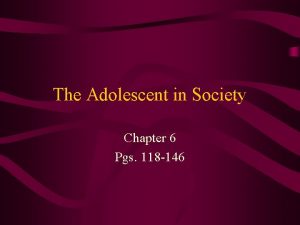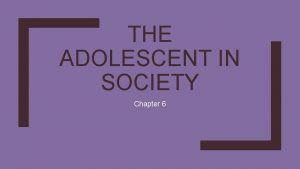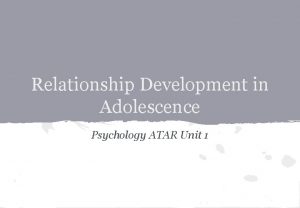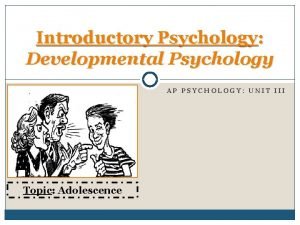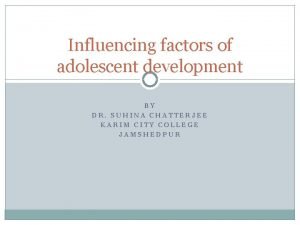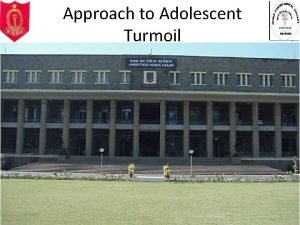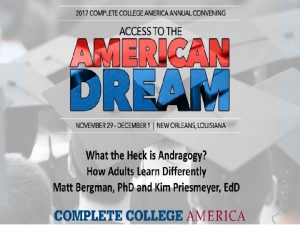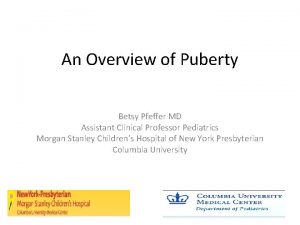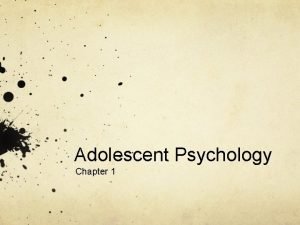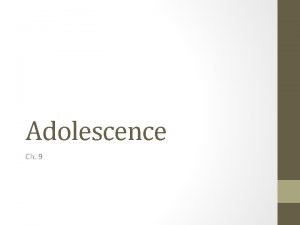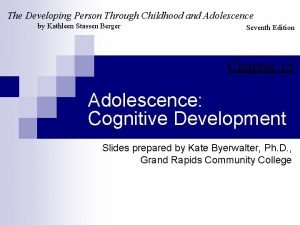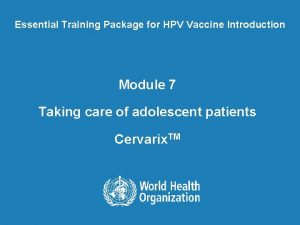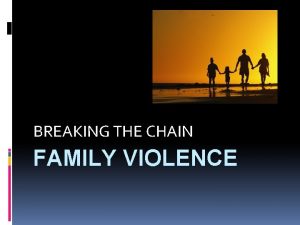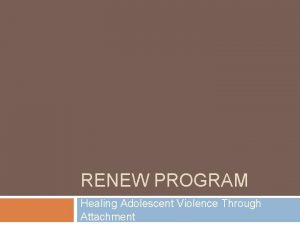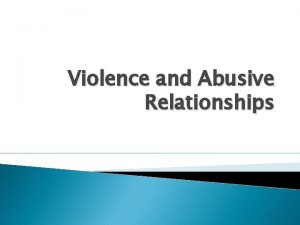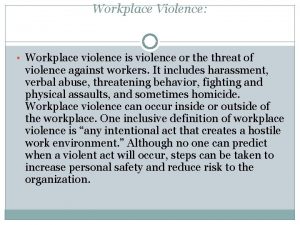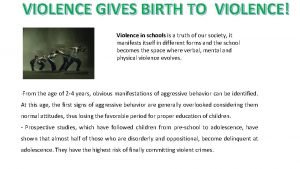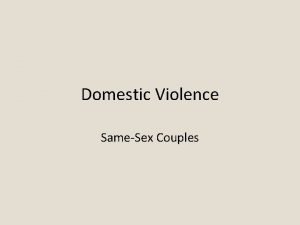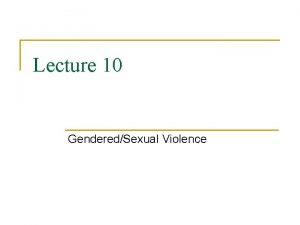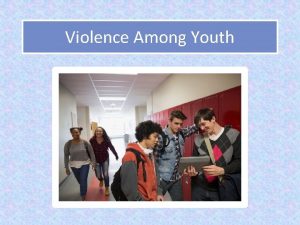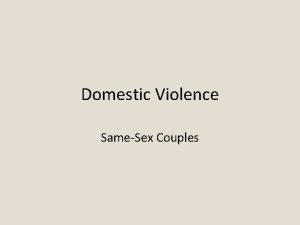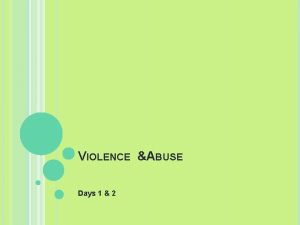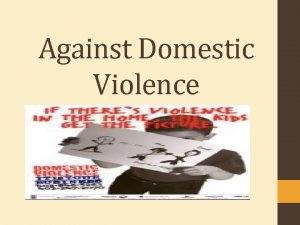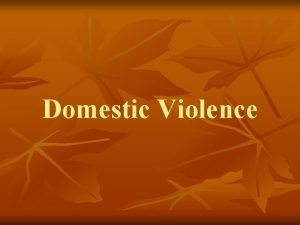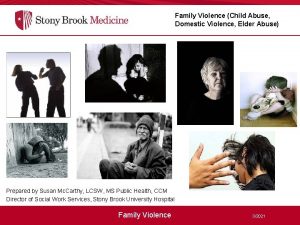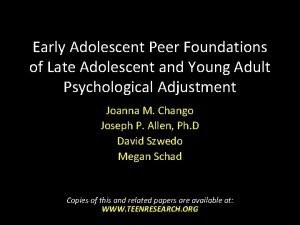ADOLESCENT FAMILY VIOLENCE AND THE KIND PROGRAM Lauren






























- Slides: 30

ADOLESCENT FAMILY VIOLENCE AND THE KIND PROGRAM Lauren Moulds lgmoulds@deakin. edu. au Ph. D. Candidate – School of Psychology, Faculty of Health, Deakin University, Victoria Senior Psychologist – Youth Justice, Department of Human Services, South Australia Deakin University CRICOS Provider Code: 00113 B

ACKNOWLEDGEMENTS Team A: Dr Helen Mildred Professor Andrew Day Professor Peter Miller Dr Richelle Mayshak WA, SA, VIC, NSW and QLD Police OCSAR Deakin University CRICOS Provider Code: 00113 B Team B: Youth Justice Psychology Services Youth Justice, DHS Office for Women, DHS

1. ADOLESCENT FAMILY VIOLENCE 3

Perpetrator AFV Paper: Moulds, L. G. , et al (2016), “Adolescent violence towards parents – the known and unknowns”, Australian and New Zealand Journal of Family Therapy, Vol. 37 No. 4, pp. 547 -57, doi: 10. 1002/anzf. 1189. Deakin University CRICOS Provider Code: 00113 B victim Violence • Adolescent • 10 -17 years of age • parent • sibling • grandparent • extended family • physical • psychological • sexual • financial • social

VICTORIAN ROYAL COMMISSION INTO FAMILY VIOLENCE (2016) • 1 in 10 family violence incidents perpetrated by adolescent --- Sibling Violence accounted for approximately 20% of these family violence incidents perpetrated by an adolescent. • Increasing • Criminal action taken in 16% of cases • 64% male perpetrator • 80% female victim Deakin University CRICOS Provider Code: 00113 B

PREVALENCE Review of Literature: Approximately one in ten families in the community experience AVTP, with this figure rising to one in four in clinical and forensic settings. Australian Data: Within Australia AVTP is between 1 -7% of cases of FV reported to the police. Paper: Moulds. , et al (2018). Adolescent violence towards parents – prevalence and characteristics using Australian Police Data, Australian and New Zealand Journal of Criminology, In Press 6

INCIDENTS ● 70% of cases occurred in metropolitan areas ●More commonly a pattern vs a one off incident ● Response is not well informed by risk or what could be potential key risk factors. Paper: Moulds. , et al (2018). Adolescent violence towards parents – prevalence and characteristics using Australian Police Data, Australian and New Zealand Journal of Criminology, In Press 7

PERPETRATORS ●The ‘typical’ perpetrator is a 15 -17 -year-old Caucasian young man ● 2/3 of incidents of AVTP were committed by 14 -17 year olds ●Drug and alcohol issues, trauma, mental health issues and other offending Paper: Moulds, L. G. , & Day, A. (2017). Characteristics of adolescent violence towards parents—A rapid evidence assessment. Journal of Aggression, Conflict and Peace Research, 9(3), 195– 209. 8

STEVEN - Male, ATSI, Identifies as Ngarrindjeri , 17 - GOM since 8 years of age - Cultural and family trauma – around displacement, grief, loss and disconnection - History of chronic neglect, physical and emotional abuse and exposure to family violence - Offending behaviour since 10 – long periods in custody - Drug and alcohol use - PTSD - + ongoing acute trauma and rejection - Violent girlfriend, particularly on phone in custody 9

Extensive family history of displacement, grief and trauma no positive experiences of relationships or connection Experience of abuse, neglect and witness of violence relationships, love and care unsafe Violence as norm within relationships

VICTIMS ● 70 -80% Women - Regardless of whether single parent, in relationship or step parent ●Often women in their 40 s ●Drug and alcohol issues, trauma, mental health issues 11

IMPACTS Systematically: Stereotypical view of family Parent: poor physical and psychological health, economic hardship, shame, stigma, blame and isolation Cycles of victimisation/perpetration Justice response Family violence services and understandings Adolescent: schooling, mental health, relationships, criminal behaviour and suicide attempts Deakin University CRICOS Provider Code: 00113 B Family: isolation, break down in relationships, change in focus, modelling to siblings

IT’S COMPLICATED… ● Children – perpetrator and to be protected ● Parents – responsible party and victim ● Parental blame Paper: Moulds, L. G. , et al (2016), “Adolescent violence towards parents – the known and unknowns”, Australian and New Zealand Journal of Family Therapy, Vol. 37 No. 4, pp. 547 -57, doi: 10. 1002/anzf. 1189. 13

AVTP AND OFFENDING ● Adolescent Violence towards parents (AVTP) and offending ● groups of AVTP offenders; ○ solely AVTP offenders (who have no other offending) ○ AVTP non-violent offenders who have committed other nonviolent crimes ○ AVTP violent offenders, who have committed other violent crimes outside of their AVTP offence. ● AVTP rarely occurs in isolation, without any other offending ● Most AVTP offenders commit other non-violent or violent offenders - regardless of gender or indigenous group ● AVTP part of a general pattern of offending ● However unique from adolescent violence towards others – with unique characteristics and trajectory Paper: Moulds. , et al (2018). Adolescent violence towards parents – a case of specialisation? , Psychiatry, Psychology and Law, Under Review

VICTIMS OR VICTIMISERS? Perpetrators of violence in families Witnessing violence in families perpetrators of dating violence Victim of child maltreatment Victims of dating violence 15

See: Malvaso, C. , Delfabbro, P. , Day, A. , & Nobes, G. (2018). The maltreatment-violence link: Exploring the role of maltreatment experiences and other individual and social risk factors among young people who offend. Journal of Criminal Justice, 55, 35 -45. Malvaso, C. , Delfabbro, P. , & Day, A. (2017). The child protection and juvenile justice nexus in Australia: A longitudinal examination of the relationship between maltreatment and offending. Child Abuse and Neglect, 64, 32 -46.

3. Pilot program in SA Youth Justice (DHS): KIND 17


Review Paper Consultation AFV/ADV Reference Group 19

KIND PROGRAM • Perpetrator program – within Youth Justice • • Youth Justice + Office for Women • • Working WITH family (cultural understanding) Working with partners (if they want) Individual sessions, parent sessions + family sessions – group = family Deakin University CRICOS Provider Code: 00113 B • Skill development • Based on RNR principle, Matched intervention, CBT approaches • Tailored to individual and their family needs • Strong connections with victim services and adult perpetrator programs • Approximately 19 sessions over 3 months • Safety Planning – in every session

TIP FOR ADOLESCENT FAMILY VIOLENCE Development of safety Promotion of healing relationships Teaching of self management and coping skills A systemic approach to family violence work across lifespan of family violence -> often same families experiencing intergenerational family trauma - Importance of cross referral 21

HOW KIND TRAUMA INFORMED Development of safety • safety planning for all participants • run where all feel safe • culturally sensitive and empowering • transparency of content • Clinical and cultural supervision of facilitators Deakin University CRICOS Provider Code: 00113 B Promotion of healing relationships • establishing rapport • peer support • facilitators • family inclusive • Individual and “group”/family sessions Teaching of self management and coping skills • to all family members • tailoring to learning needs and responsivity of family • strengths based • developmentally driven • individualised

INDIVIDUAL SESSIONS – 9 SESSIONS Values, committed action Circles of trust, safety planning, awareness building - gaining a sense of "thresholds" what is okay/not okay Skill building: problem solving, emotional regulation, assertive communication Chain Analysis of AFV incidents and discussions around alternative pathways

PARENT SESSIONS – 6 SESSIONS circles of trust, safety planning, awareness building gaining a sense of "thresholds" - what is okay/not okay skill building: emotional regulation, assertive communication Chain Analysis of AFV incidents and discussions around alternative pathways values, committed action and transparency Self Care

FAMILY SESSIONS – AFV – 3 SESSIONS skill building: conflict resolution, respect and reconciliation safety planning, support networks

KIND REFERRAL STATISTICS

OUTCOMES AND FEEDBACK o Currently being evaluated o Main changes o Risk – no real change in category, but change in points/degree o Improved coping skills o Improved family relationships, in particular, family satisfaction and communication o Change in attitudes regarding violence – for both family/partners and the individual o Feedback o Most valuable – having family involved and doing same things with them o Enjoyed values work as a grounder o Liked group sessions the best o Least liked – many families reported it wasn’t long enough

IMPLEMENTATION, DELIVERY AND LONG-TERM PROSPECTS - Funding “one person” show Training of 40 staff Evaluation - ++ suggested the continuation of the program and spoke of its effectiveness - However – resources, funding, and personnel changes -> not currently being run Deakin University CRICOS Provider Code: 00113 B

TAKE HOME MESSAGES 1. Approximately 1 in 10 family violence incidents in Australia are perpetrated by an adolescent 2. Most victims are women, typically mothers, and is typically perpetrated by males 3. Often the victim, perpetrator and family have experienced trauma 4. The violence is often part of a bigger picture of violent offending 5. The KIND program– Youth Justice Program for adolescent violence towards family and partners 6. Trauma informed care crucial due to complexities Deakin University CRICOS Provider Code: 00113 B

THANKS! Any questions? lgmoulds@deakin. edu. au
 Adolescent family violence program
Adolescent family violence program Family violence intervention program atlanta
Family violence intervention program atlanta Family violence intervention program georgia
Family violence intervention program georgia Domestic and family violence protection act 2012
Domestic and family violence protection act 2012 Domestic and family violence protection act 2012
Domestic and family violence protection act 2012 Routine, universal screening for domestic violence means
Routine, universal screening for domestic violence means Family violence
Family violence Facilitating learning child and adolescent development
Facilitating learning child and adolescent development Infant child and adolescent berk 8th edition chapter 1
Infant child and adolescent berk 8th edition chapter 1 Circuit solutions fresno
Circuit solutions fresno Pre adolescent girl
Pre adolescent girl Challenges faced by filipino middle and late adolescence
Challenges faced by filipino middle and late adolescence Undefined status adolescence
Undefined status adolescence Undefined status adolescence
Undefined status adolescence The adolescent in society guided reading section 2
The adolescent in society guided reading section 2 Dunphy's 5 stages
Dunphy's 5 stages Adolescence ap psychology
Adolescence ap psychology Factors that influence adolescent development?
Factors that influence adolescent development? Ego strength erikson
Ego strength erikson Integrity despair
Integrity despair Elkind's theory of adolescent egocentrism
Elkind's theory of adolescent egocentrism Adolescence period meaning
Adolescence period meaning Adolescent turmoil definition
Adolescent turmoil definition The art and science of helping adults learn
The art and science of helping adults learn Early adolescent age
Early adolescent age Adolescent generalization gap
Adolescent generalization gap Developmental tasks for adolescent
Developmental tasks for adolescent Adolescent generalization gap
Adolescent generalization gap Moral development in adolescence
Moral development in adolescence Adolescent egocentrism
Adolescent egocentrism Adolescent definition
Adolescent definition
